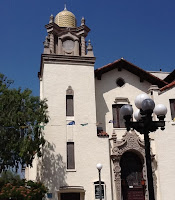By Nancy J. Farrier
Tourists who visit Los Angeles enjoy going to Olvera Street,
a short block full of touristy shops and
cultural foods. I was there early this summer and meandered through to the sounds of Hispanic music and the noise of the crowd. About the middle of the block a charming house caught my eye—the Avila House. I was too late to visit the museum inside, but read the plaque outside and learned the house had been there for almost 200 years. That sparked my interest and I had to do some research.
cultural foods. I was there early this summer and meandered through to the sounds of Hispanic music and the noise of the crowd. About the middle of the block a charming house caught my eye—the Avila House. I was too late to visit the museum inside, but read the plaque outside and learned the house had been there for almost 200 years. That sparked my interest and I had to do some research.
In 1818, Don Francisco Jose Avila, a ranchero and alcalde, or
mayor, of Los Angeles, began to build a house in town. Many of the rancheros
lived outside the town, but would keep homes closer to town to entertain
friends and family or for when they attended church.
Don Francesco Avila was well known for his hospitality.
Don Francesco Avila was well known for his hospitality.
Don Avila lived in the house with his wife, Encarnacion, and
his two daughters. The original home was much more spacious than the restored
house on Olvera Street today. Don Avila’s house, made of sun-baked adobe
bricks, had walls 2 ½ to 3 feet thick. The ceilings were 15 feet high,
supported by cottonwood beams. They used natural tar from the Brea tar pits,
mixed with rocks and horsehair, to coat and seal the roof. Behind the home they had
a vineyard, one of many in the area.
In 1832, Don Avila died. He had been 50 when he married
15-year-old Encarnacion. She and her two daughters continued to live in the
Avila house. However, during the Mexican-American war, Robert “Fighting Bob” Stockton, a
U.S. Navy Commander, commandeered the Avila House for a military headquarters. The occupation was shortlived. After
Encarnacion’s death, her daughters continued to reside in the house until 1868.
Over the next few decades, the Avila house was rented out,
made into a restaurant and became a rooming house for transients. I found
conflicting accounts about the date when the Avila House was condemned and
slated to be torn down, 1926, 1928, or 1932. The house had been allowed to
decline to the point where it wasn’t habitable.
That’s when socialite, Christine Sterling moved to Los
Angeles. She loved the city and enjoyed looking at the older areas. As she walked down a grimy alley filled with sewage, and
popular with transients and criminals, she noticed the Avila House. Christine read the notice condemning the
building and began a massive and successful campaign to save the historic home.
Today the Avila House is a museum, decorated as the home
would have been in 1840. The only original piece of furniture is a black, lacquered
table, thought to be a gift to Francisco when he married Encarnacion.
Many visiting dignitaries, movie stars and celebrities have visited
the Avila House. Senator John Kennedy is reported to have stepped on the
horseshoe at the entryway between the chapel and the kitchen and said, “I wish
to be President.” Other famous people have been entertained there in years
past.
From what I read the Avila house is the oldest existing home
in Los Angeles. If you would be interested in reading a more in-depth article,
here is the link: The Avila Adobe
Nancy J Farrier is an award winning author who lives in
Southern California in the Mojave Desert. She loves the Southwest and
interesting historical past. Nancy and her husband have five children. When
Nancy isn’t writing, she loves to read, do needlecraft, play with her cats, and
spend time with her family. Nancy is represented by Karen Ball of The Steve
Laube Literary Agency. You can read more about Nancy and her books on her
website: nancyjfarrier.com.






Loved this post and the tidbit about John Kennedy stepping on the horseshoe at the entryway between the chapel and the kitchen and saying, “I wish to be President.” Thanks for sharing!
ReplyDeletetscmshupe [at] pemtel [dot] net
Thank you, Sally. I found that tidbit about John Kennedy fascinating too.
DeleteNancy, what an interesting post. Oh, if those walls could have talked way back when and if they could talk now. Thank you!
ReplyDeleteYes, Melanie, I imagine they would have some great stories to tell.
DeleteHow interesting, Nancy I have not been to this part of our big USA, so reading today was a treat. I love older homes and this one sure was something in its day -thanks for your info
ReplyDeletePaula O
Thank you, Paula. I love old homes and the interesting architecture.
DeleteWhat interesting history the Avila House holds! Thank you for sharing.
ReplyDeleteThank you, Britney.
DeleteI've been to Olivera St. but never went to the Avila Adobe house. What an interesting place. Thanks for the research. Sharon, CA wileygreen1(at)yahoo(dot)com
ReplyDeleteI've been to Olivera St. but never went to the Avila Adobe house. What an interesting place. Thanks for the research. Sharon, CA wileygreen1(at)yahoo(dot)com
ReplyDeleteI've been to Olivera St. but never went to the Avila Adobe house. What an interesting place. Thanks for the research. Sharon, CA wileygreen1(at)yahoo(dot)com
ReplyDeleteThanks for the interesting post, Nancy! Beautiful building!
ReplyDelete